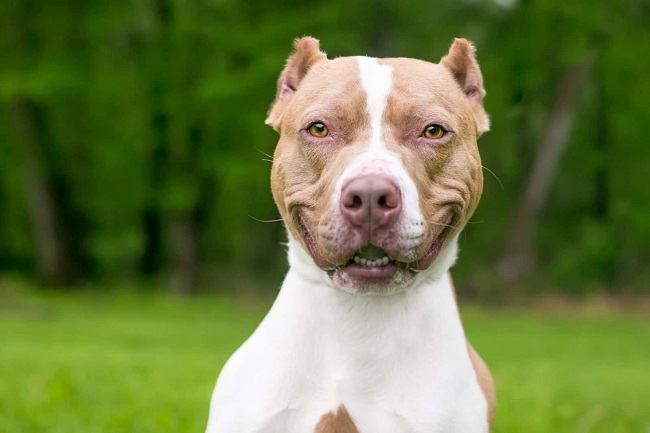Ear cropping in Pitbulls is a subject that has garnered both attention and debate among dog enthusiasts.
In this article, we aim to shed light on the practice of ear cropping, why some people choose to do it, the cost involved, the different ear crop styles, and the appropriate age for the procedure.

Why Was Ear Cropping Common in Pitbulls?
Historically, ear cropping was a practice that originated for practical reasons, particularly in working and hunting dogs. For Pitbulls, it served several purposes:
- Health and Functionality: Ear cropping was believed to reduce the risk of ear infections and injuries in working dogs, especially those used in hunting and guarding.
- Tradition and Aesthetics: In some cases, ear cropping was performed to adhere to breed standards or traditional aesthetics. Certain breed standards, particularly in the American Pit Bull Terrier and American Staffordshire Terrier, called for cropped ears.
- Distinctive Appearance: Cropped ears were thought to give Pitbulls a more imposing and alert appearance, which some owners found desirable for guarding and protection roles.
The Cost of Ear Cropping for Pitbulls
The cost of ear cropping for Pitbulls can vary widely depending on several factors:
- Location: The cost may differ based on the geographic location and the availability of experienced veterinarians who can perform the procedure.
- Veterinarian’s Expertise: Experienced veterinarians who specialize in ear cropping may charge higher fees for their services.
- Anesthesia and Aftercare: The cost includes anesthesia, the surgical procedure itself, and post-operative care, including pain management and suture removal.
- Ear Crop Style: The choice of ear crop style can influence the cost. Some styles are more intricate and time-consuming than others.
On average, ear cropping for Pitbulls can cost anywhere from $150 to $800 or more. It is crucial to choose a qualified and ethical veterinarian who prioritizes the dog’s welfare and adheres to local regulations regarding ear cropping.
Different Ear Crop Styles
When it comes to ear cropping in Pitbulls, there are various styles to choose from, including:
- Short Crop: This style leaves the ears relatively short and upright, giving the dog a more alert appearance.
- Show Crop: Show crops are longer and more pointed, adhering to breed standards for certain breeds. They create a distinctive, elegant look.
- Battle Crop: This style results in shorter ears with a more rugged appearance, often chosen for working dogs.
- Long Crop: Long crops are characterized by longer, more tapered ears, providing a unique aesthetic.
The choice of ear crop style is typically a matter of personal preference and adherence to breed standards where applicable.
Appropriate Age for Ear Cropping
The age at which ear cropping is performed is a topic of concern among veterinarians and animal welfare advocates. In most cases, it is recommended to perform ear cropping when the Pitbull is between 7 and 16 weeks old.
This age range is considered optimal because the puppy’s ears are still soft and pliable, allowing for easier surgical manipulation and healing.
Is Home Ear Clipping for Pitbulls Advisable?
Before exploring the process, it’s crucial to emphasize that ear cropping should ideally be done by a licensed veterinarian. Veterinarians have the necessary training, expertise, and sterile environments to perform the procedure safely and ethically.
Attempting to crop a dog’s ears at home carries significant risks, including infection, pain, and complications.
The Ear Cropping Process
If you’re still interested in learning about the ear cropping process for informational purposes, here’s a simplified overview:
- Age Consideration: Ear cropping is typically performed when a Pitbull is between 7 and 16 weeks old. The puppy’s ears are soft and pliable at this age, making the procedure less traumatic.
- Anesthesia: The puppy is placed under general anesthesia to ensure it feels no pain during the surgery.
- Marking: The veterinarian marks the desired ear shape on the puppy’s ears. The choice of ear crop style should have been discussed with the veterinarian beforehand.
- Surgical Procedure: The veterinarian makes incisions along the marked lines and removes excess tissue. The remaining ear tissue is sutured into the desired shape.
- Post-Operative Care: The puppy is closely monitored during recovery. Pain management and antibiotics may be prescribed to prevent infection and alleviate discomfort.
Why Ear Cropping Is Controversial
Ear cropping is a controversial practice due to several factors:
- Pain and Trauma: The procedure is painful, and recovery can be uncomfortable for the puppy.
- Aesthetic vs. Welfare: Many argue that ear cropping is primarily done for aesthetic reasons and does not necessarily benefit the dog.
- Ethical Concerns: In some countries and regions, ear cropping is considered unethical and is even banned.
Alternative Options
If you want your Pitbull to have a certain appearance without ear cropping, there are alternative options to consider:
- Natural Ears: Embrace your Pitbull’s natural ear shape, which can be just as charming and unique.
- Ear Taping: For some breeds, such as Great Danes, ear taping can be used to encourage the ears to stand upright naturally.
- Consult a Groomer: Speak to a professional groomer who can suggest hairstyles or grooming techniques to achieve your desired look without resorting to ear cropping.
Conclusion
Ear cropping in Pitbulls is a practice rooted in tradition, aesthetics, and historical considerations. While some owners choose to crop their Pitbull’s ears, it’s essential to prioritize the dog’s welfare and adhere to local regulations.
The cost of ear cropping can vary, and the choice of ear crop style is a matter of personal preference. When considering ear cropping, it’s crucial to consult with a qualified veterinarian who can provide guidance and perform the procedure ethically and safely.
